

Babylonian Talmud: Tractate Baba Bathra
AND SIX1 HANDBREADTHS IN WIDTH.2 R. SIMEON SAYS: THE CENTRAL SPACE OF THE GROTTO MUST CONTAIN [AN AREA OF] SIX CUBITS BY EIGHT. AND THIRTEEN CHAMBERS ARE TO OPEN OUT INTO IT; FOUR ON ONE SIDE, FOUR ON THE OTHER. THREE IN FRONT [OF THE ENTRANCE]. ONE ON THE RIGHT OF THE ENTRANCE AND ONE ON THE LEFT.3 OUTSIDE THE ENTRANCE TO THE GROTTO IS TO BE MADE A COURT OF SIX [CUBITS] BY SIX, [WHICH IS] THE SPACE THE BIER AND THOSE WHO BURY IT OCCUPY. TWO GROTTOS4 ARE TO BE OPENED OUT INTO IT; ONE ON THE ONE SIDE AND ONE ON THE OTHER.5 R. SIMEON SAYS: FOUR; [ONE] FOR [EACH OF] ITS FOUR SIDES.6 R. SIMEON B. GAMALIEL SAYS: ALL DEPENDS ON [THE QUALITY OF] THE ROCK.7
GEMARA. Where are these two [chambers]8 to project? If outwards,9 they would, surely, be trodden upon!10 Furthermore, we have learnt:11 'He who stands12 in the court of a [family] grave is [Levitically] clean'.13 — R. Jose b. Hanina replied: They are made in the shape of a door-bolt.14 But, Surely. R. Johanan said:
- Or one cubit.
- A space of one cubit was allowed for each of the walls intervening between the sepulchral chambers, and half a cubit space was left at the end of each wall. The two longer walls of the grotto, being respectively six cubits in length, could, therefore, contain three chambers each: The chambers, each of one cubit in width, occupying three cubits; the two walls between them, two cubits; and the two half cubit spaces at the corners, another cubit. The shorter wall facing the entrance, being four cubits long, could contain two chambers only: the chambers occupying two cubits; the intervening wall, one cubit; and the two half cubit spaces at the corners, another cubit.
- According to R. Simeon, the longer walls, being eight cubits in length. provide space for four one-cubit chambers each, allowing three cubits for the intervening one-cubit walls, and one cubit space for the two half cubit spaces at the corners. The wall opposite the entrance, being six cubits in length, can contain three one-cubit chambers, the space for the two one-cubit intervening walls and the two half-cubit spaces at the corners. This gives a total of, (4 + 4 + 3), eleven sepulchral chambers. The location of the last two is dealt with in the Gemara infra.
- The one mentioned, and another facing it.
- The following diagram represents the plan and the area of the entire cave, court, grottos and sepulchral chambers, in accordance with the regulations laid down by the Rabbis, (the representatives of the anonymous opinion cited first in the Mishnah).
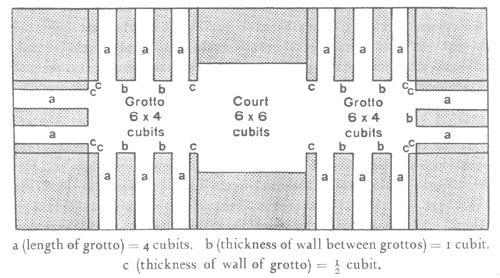
- According to R. Simeon the plan and dimensions of the grave are as follows:
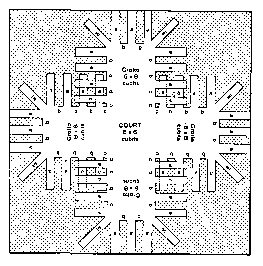
- If the rock is hard, more sepulchral chambers may be cut, since less space is required for the intervening walls. If, on the other hand, the ground is soft, more space would be required for the walls and, consequently, the number of chambers would have to be reduced.
- Which, according to R. Simeon, are to be cut on the right and on the left of the entrance.
- Under the floor of the court.
- By those who have to pass the court into the grottos; and treading upon a grave is an insult to the dead, which is forbidden.
- Oh. XV, 8.
- I.e., if he was carried into the court, not having trodden upon the surrounding graves.
- But if the graves were projecting into the court, as assumed, he would have become Levitically unclean on account of his treading on these graves.
- The chambers are dug vertically and the bodies are placed in an upright Position.
Baba Bathra 101b
'This1 is the burial of asses'? — According to R. Johanan they are made in the corner[s].2 But, surely, the chambers would touch3 each other? — R. Ashi replied: One can make them deeper.4 For if you would not say so,5 how can four grottos be constructed according to R. Simeon? Surely [some of] the chambers [of adjacent grottos] would be touching6 each other! But [this. you would say, can be avoided] by digging [the overlapping chambers] deeper [than the others];7 in this case also, [the touching of chambers may be avoided] by digging [the corner chambers] into the wall deeper [than the adjacent ones]. R. Huna the son of R. Joshua stated: The [affected chambers in the] four grottos, according to R. Simeon, were made in the shape of palm-wigs.8 But this [statement of R. Huna b. R. Joshua is [to be] rejected.9 For, it is to be observed, every cubit square has a diagonal of a cubit and two fifths [approximately]. [The diagonal of the square formed by the adjacent walls of any two grottos] measures eleven cubits and a fifth,10 [approximately]. Is not the number of the chambers eight?11 How, [then], is it possible [to make eight [chambers]12 in [a width of] eleven [cubits] and a fifth? But that [statement] of R. Huna b. R. Joshua must be rejected. If you like, it may be said: As R. Shisha son of R. Idi [referred the case, infra.] to miscarriages, [so] here also [the chambers in question are for the burial] of miscarriages.13
We have learnt elsewhere [in a Mishnah]:14 If a corpse is found15 lying [in a grave] in the usual manner.16 both the corpse and the earth surrounding it are to be removed.17 [If] two [corpses, in similar conditions, are found], they and the earth surrounding them are to be removed.
- I.e., burial in an upright position.
- The corners formed by the wall facing the entrance and the respective two walls adjacent to it, the chambers projecting into the corners in a slanting direction. V. fig. 1.
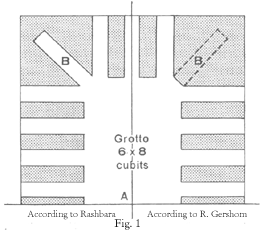
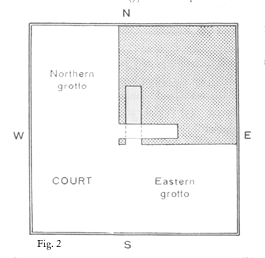
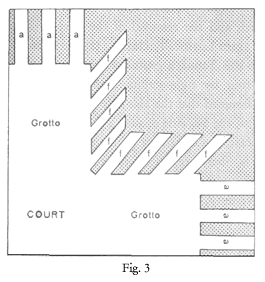
- A width of one cubit is required for each chamber, while the entire space vacant in the corners is only half a cubit in either wall, thus leaving no intervening walls between the chambers in the corners and the adjacent chambers on either side.
- The deeper one digs into the corners in a slanting direction, the further becomes the distance between the corner chambers and those adjacent to them (Rash.) R. Gershom explains that he digs the corner ones deeper in the ground, that is lower than the adjacent ones, cf. Jerushalmi, a.l.
- That some of the chambers were dug deeper than the others.
- The chamber in the northwestern corner of the eastern grotto, for example. would coalesce with the south-eastern chamber of the northern grotto. V. fig. 2.
- Deeper in the ground and lower than the corresponding chambers in the other grotto.
- Fan shape; and this would avoid overlapping or coalescing and the necessity for deeper digging.
- [H] var. lec. [H] 'imaginary'. V. B.M. 9a. n. 00.
- Each of the two walls being eight cubits in length, a square is formed whose diagonal is 8 + (8 x 2) / 5 = 11 1/5 cubits approximately.
- Four in the wall of each grotto.
- Each one of which is to be a cubit in width. Add to this the widths of the seven intervening walls, each also of one cubit, making a total of fifteen cubits.
- Or, newly-born infants. The corner chambers as well as those which, according to R. Simeon's plan, would overlap, are to be used for burial of small bodies which occupy little space. Small burial chambers would not coalesce with, or touch the others.
- Oh. XVI, 3.
- In an area which is not known to be a graveyard and, therefore, Levitically clean.
- Showing that Israelites had buried it and that death was due to natural causes; and the question, therefore, arises whether that area was not once used as a regular graveyard. In the case of a mutilated corpse or non-Jewish mode of burial, that question does not arise, since it is obvious that the corpse was buried in that spot by mere accident.
- If the area is to remain Levitically clean. The discovery of one corpse does not establish the area as a graveyard, and the removal of the corpse in the manner prescribed, renders the area again Levitically clean.

